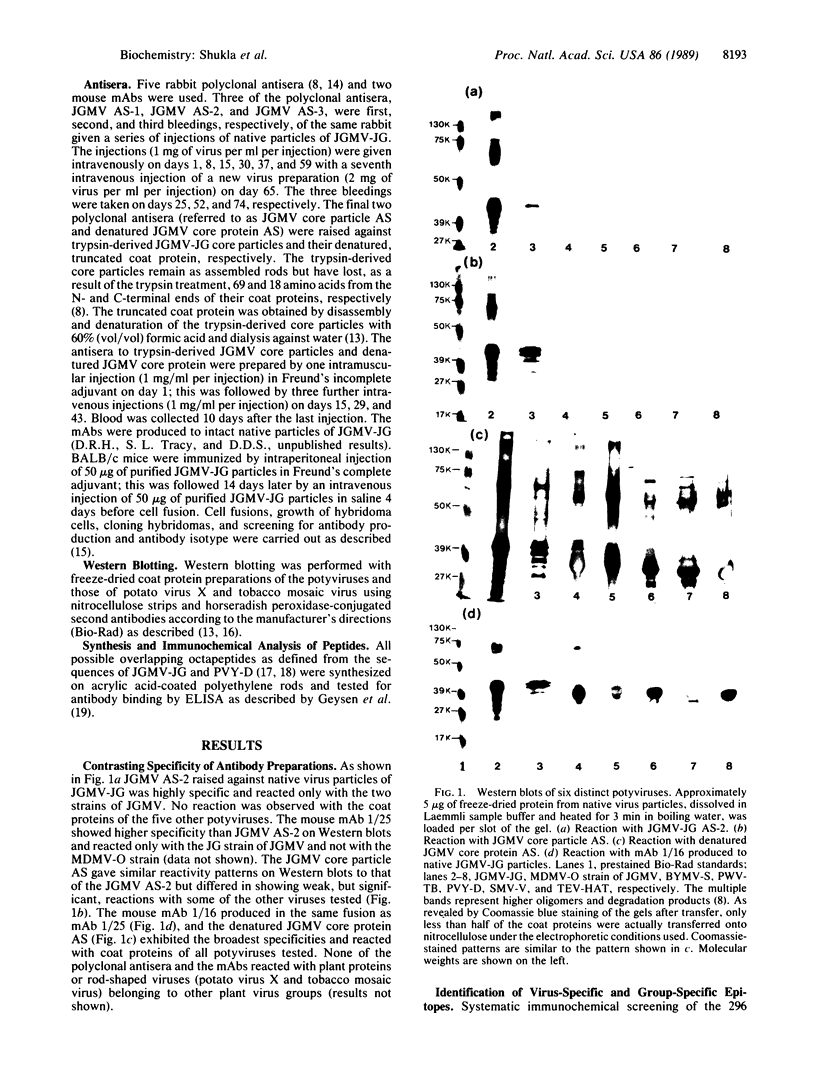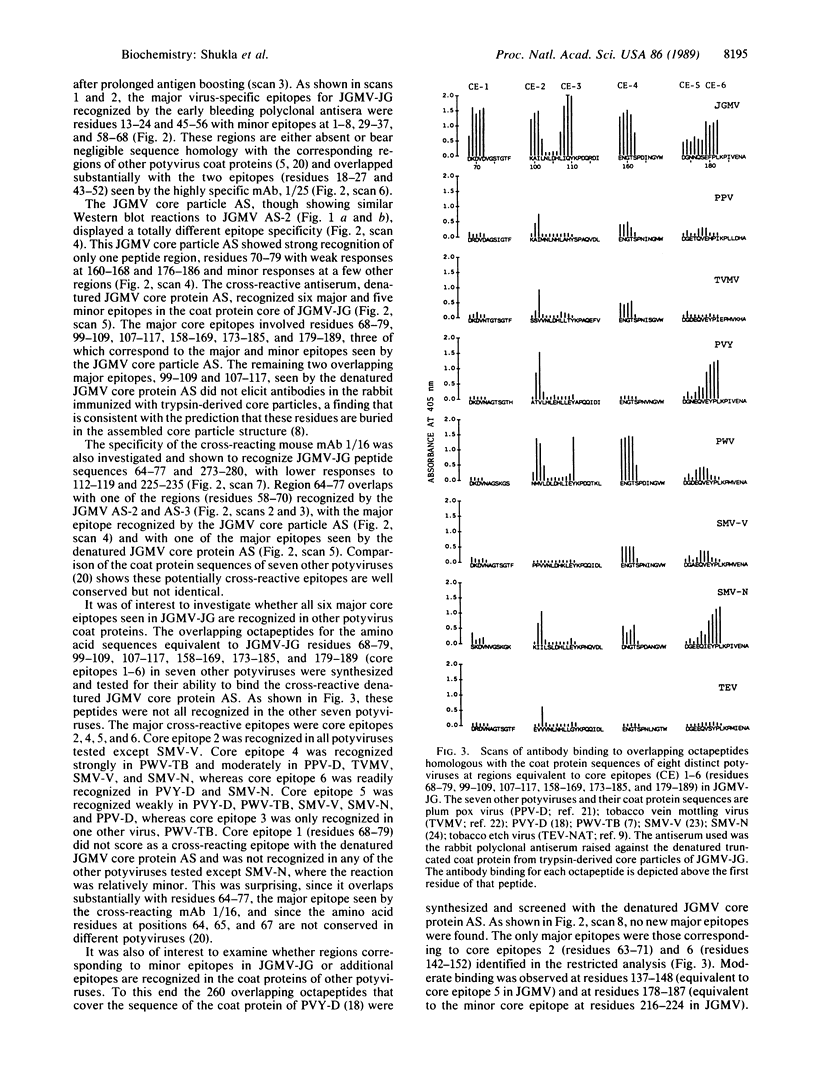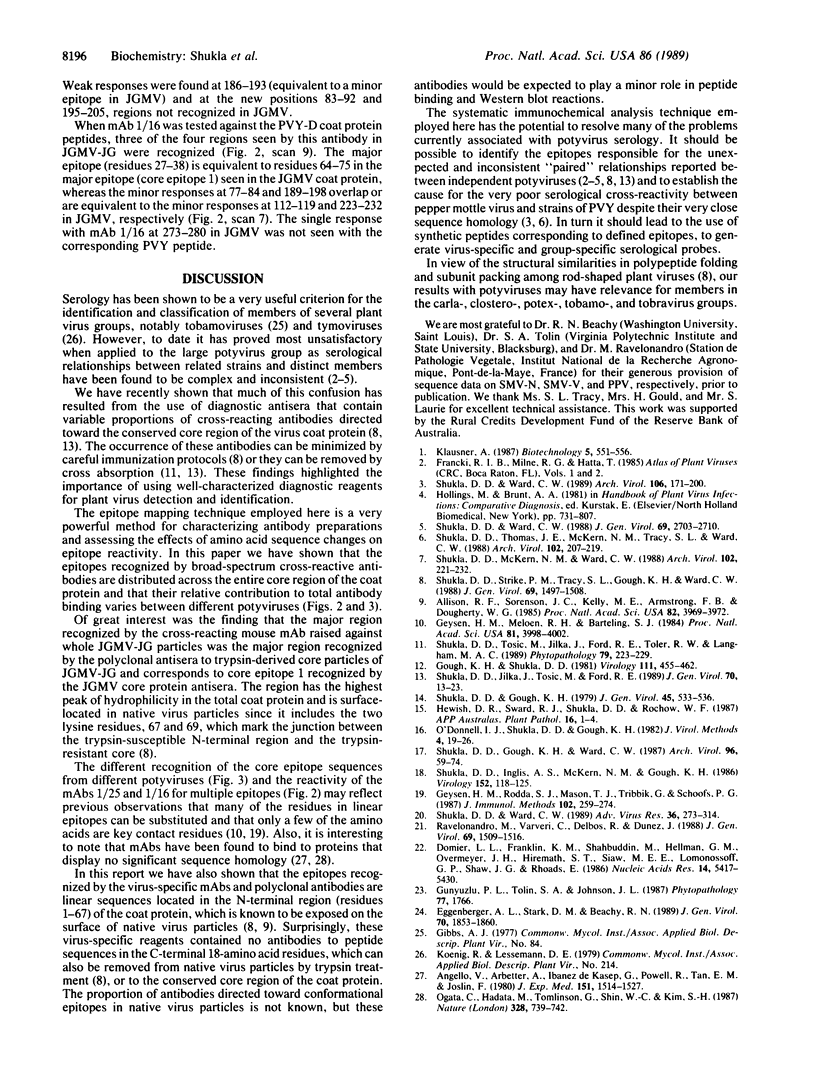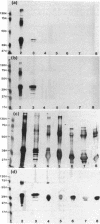Abstract
Virus-specific or group-specific antibody probes to potyviruses can be produced by targeting the immune response to the virus-specific, N-terminal region of the capsid protein (29-95 amino acids depending on the virus) or to the conserved core region (216 amino acids) of the capsid protein, respectively. Immunochemical analysis of overlapping, synthetic octapeptides covering the capsid protein of the Johnsongrass strain of Johnsongrass mosaic virus (JGMV-JG) has delineated the peptide sequences recognized by five polyclonal rabbit antisera and two mouse monoclonal antibodies (mAbs). The antibodies characterized were (i) three virus-specific rabbit polyclonal antisera and one virus-specific mouse mAb (1/25) raised against native virus particles, (ii) one polyclonal antiserum raised against trypsin-derived core particles of JGMV-JG, (iii) one group-specific polyclonal antiserum raised against the denatured, truncated coat protein from trypsin-derived core particles of JGMV-JG, and (iv) one group-specific mouse mAb (1/16) raised against native virus particles. The two epitopes seen by mAb 1/25 occurred at residues 18-27 and 43-52 and overlapped with the two major epitopes seen by the virus-specific polyclonal antiserum. The group-specific epitope seen in JGMV-JG by mAb 1/16 was also recognized strongly in potato virus Y, the type member of the potyvirus group. The multiple epitopes seen by the cross-reactive polyclonal antisera were distributed across the entire core region of the coat protein and their relative antibody binding responses varied between JGMV-JG, potato virus Y, and six other distinct potyviruses.
Full text
PDF




Images in this article
Selected References
These references are in PubMed. This may not be the complete list of references from this article.
- Agnello V., Arbetter A., Ibanez de Kasep G., Powell R., Tan E. M., Joslin F. Evidence for a subset of rheumatoid factors that cross-react with DNA-histone and have a distinct cross-idiotype. J Exp Med. 1980 Jun 1;151(6):1514–1527. doi: 10.1084/jem.151.6.1514. [DOI] [PMC free article] [PubMed] [Google Scholar]
- Allison R. F., Sorenson J. C., Kelly M. E., Armstrong F. B., Dougherty W. G. Sequence determination of the capsid protein gene and flanking regions of tobacco etch virus: Evidence for synthesis and processing of a polyprotein in potyvirus genome expression. Proc Natl Acad Sci U S A. 1985 Jun;82(12):3969–3972. doi: 10.1073/pnas.82.12.3969. [DOI] [PMC free article] [PubMed] [Google Scholar]
- Domier L. L., Franklin K. M., Shahabuddin M., Hellmann G. M., Overmeyer J. H., Hiremath S. T., Siaw M. F., Lomonossoff G. P., Shaw J. G., Rhoads R. E. The nucleotide sequence of tobacco vein mottling virus RNA. Nucleic Acids Res. 1986 Jul 11;14(13):5417–5430. doi: 10.1093/nar/14.13.5417. [DOI] [PMC free article] [PubMed] [Google Scholar]
- Eggenberger A. L., Stark D. M., Beachy R. N. The nucleotide sequence of a soybean mosaic virus coat protein-coding region and its expression in Escherichia coli, Agrobacterium tumefaciens and tobacco callus. J Gen Virol. 1989 Jul;70(Pt 7):1853–1860. doi: 10.1099/0022-1317-70-7-1853. [DOI] [PubMed] [Google Scholar]
- Geysen H. M., Meloen R. H., Barteling S. J. Use of peptide synthesis to probe viral antigens for epitopes to a resolution of a single amino acid. Proc Natl Acad Sci U S A. 1984 Jul;81(13):3998–4002. doi: 10.1073/pnas.81.13.3998. [DOI] [PMC free article] [PubMed] [Google Scholar]
- Geysen H. M., Rodda S. J., Mason T. J., Tribbick G., Schoofs P. G. Strategies for epitope analysis using peptide synthesis. J Immunol Methods. 1987 Sep 24;102(2):259–274. doi: 10.1016/0022-1759(87)90085-8. [DOI] [PubMed] [Google Scholar]
- O'Donnell I. J., Shukla D. D., Gough K. H. Electro-blot radioimmunoassay of virus-infected plant sap - a powerful new technique for detecting plant viruses. J Virol Methods. 1982 Feb;4(1):19–26. doi: 10.1016/0166-0934(82)90050-7. [DOI] [PubMed] [Google Scholar]
- Ogata C., Hatada M., Tomlinson G., Shin W. C., Kim S. H. Crystal structure of the intensely sweet protein monellin. Nature. 1987 Aug 20;328(6132):739–742. doi: 10.1038/328739a0. [DOI] [PubMed] [Google Scholar]
- Shukla D. D., McKern N. M., Ward C. W. Coat protein of potyviruses. 5. Symptomatology, serology, and coat protein sequences of three strains of passionfruit woodiness virus. Arch Virol. 1988;102(3-4):221–232. doi: 10.1007/BF01310827. [DOI] [PubMed] [Google Scholar]
- Shukla D. D., Thomas J. E., McKern N. M., Tracy S. L., Ward C. W. Coat protein of potyviruses. 4. Comparison of biological properties, serological relationships, and coat protein amino acid sequences of four strains of potato virus Y. Arch Virol. 1988;102(3-4):207–219. doi: 10.1007/BF01310826. [DOI] [PubMed] [Google Scholar]
- Shukla D. D., Ward C. W. Identification and classification of potyviruses on the basis of coat protein sequence data and serology. Brief review. Arch Virol. 1989;106(3-4):171–200. doi: 10.1007/BF01313952. [DOI] [PubMed] [Google Scholar]
- Shukla D. D., Ward C. W. Structure of potyvirus coat proteins and its application in the taxonomy of the potyvirus group. Adv Virus Res. 1989;36:273–314. doi: 10.1016/s0065-3527(08)60588-6. [DOI] [PubMed] [Google Scholar]



